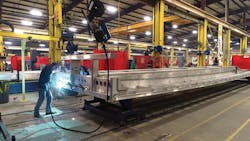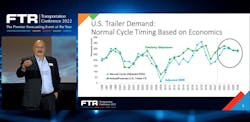The struggle continues for truck, trailer OEMs to manage fleet demand
Supply chain problems hit about a year and a half ago. Today, truck and trailer OEMs still can’t keep up with a commercial vehicle equipment market reacting stronger than economically derived demand (EDD).
Pent-up demand for the Class 8 commercial vehicle equipment market is estimated at 150,000 trucks and just over 100,000 trailer units, according to Don Ake, the retiring vice president of commercial vehicles at FTR Transportation Intelligence.
“Both on the truck side and trailer side, the OEMs are managing their business very similarly,” Ake said during FTR’s 2022 Transportation Conference in Indianapolis. “When you’ve got different companies managing the same way, they’re doing it right. You can be frustrated with the OEM performance, but that’s wrong. These people know how to manage under tough conditions, and they know how to manage under a tough supply chain. We’ve never seen a tougher supply chain than we have now.”Class 8 outlook
Some truck OEMs started entering order volumes for 2023, but their forecasts remain conservative. For the most part, Ake noted, OEMs have not yet booked 2023 fleet requirements because they don’t know what their capacity is going to be next year based on ongoing supply chain challenges.
“The supply chain remains stuck,” Ake said. “The OEMs say, ‘The problem is we have no visibility.’ They put off making quotes and finalizing deals because they are unsure of what their costs are. So, to give reasonable, realistic quotes that are fair both for the OEM and to the fleet, they put off entering orders.”
“OEMs still have to be cautious so that when they fill in 2023, it will probably be just a quarter at a time,” he added. “They are going to be very, very careful. But the potential backlog is huge. That potential backlog could be 400,000 units.”
See also: Equipment supply chain poised to meet pent-up fleet demand in 2023
Over the past year, however, signs of OEM retail sales started to pick up. From May 2021 to July of this year, OEM Class 8 retail sales have increased 13%, according to FTR data. Putting the forecast for 2022 in perspective, Ake said “it is not a bad year, all things considered.”
Heading into 2023, FTR does forecast that the supply chain and production will begin to improve in the second quarter, with many of those improvements carrying over into Q3 and Q4.
“When we look at the shipments from a factory basis, we see it will improve 10% next year,” Ake said. Our forecast says 10% based on the EDD model we looked at. The economy has to hang in there. The economy has to generate freight. As long as freight is being generated, this forecast is solid.”
Ake did note that FTR’s forecast for 2022 does not include a recession. If anything, he said the risk for a recession—in FTR’s opinion—is early next year. In that case, FTR’s projections would change significantly.
“If a recession hits, how many of those orders stick? I am not even going to speculate on that,” Ake said. “That is a very tenuous number. The backlog will probably never hit 400,000, but we’ll see.”
Trailer market
Similar to Class 8, fleet demand for trailers is strong, with significant pent-up demand due to supply chain constraints continuing to restrict OEM output. FTR forecasts project a slight increase in trailer OEM output in the first quarter of 2023, with higher projections for Q2 and Q3.
“From an annual basis, we have a forecast of 325,000 [units],” Ake said. “That’s a 7% increase over this year. We are saying the supply chain will improve 7% by next year.”
During FTR’s conference in Indianapolis, David Giesen, VP of sales and marketing for Stoughton Trailers, pointed out that over his 30-year tenure in the industry, he hasn’t seenthis setup in the trailer market as far as demand and capacity.Stoughton is on track to build more than 20,000 pieces of equipment this year, including chassis, dry vans, hoppers, and refrigerated trailers.
“We have the strongest demand we’ve seen in a very long time,” Giesen said. “The backlogs and the order boards don’t really reflect the demand that is out there. The backlog is near historical peaks, but it could be much larger.”
Components, materials, and labor shortages are the main factors limiting trailer production at Stoughton, Giesen explained.
“For any given week, labor might be our shortage, then the next week, it’s materials and components of some sort,” he contended. “We are dealing with line shutdowns on a regular basis because things did not arrive when we thought they were going to arrive. We are also dealing with a workforce that is hard to add to and keep.”
All trailer manufacturers, Giesen added, have had to allocate their space.
“It’s a difficult thing to do because nobody is getting what they want, including our most loyal customers,” he explained. “You end up doing a lot of trailer allocation exercises and nobody likes to hear the word allocation. We don’t like to hear the word allocation from a manufacturing standpoint when a suspension supplier says, ‘You’re only going to get X’ because we will want X plus a lot. We are saying no a lot to people, and that’s not an easy thing to do.”
See also: Keeping trailers properly utilized
Because trailer OEMs like Stoughton are trying to build out as much equipment as possible, it means that sometimes that they are overscheduling to maximize the amount of equipment they can build to meet market demands. OEMs also are seeing more red-tagged, or incomplete units parked in their yards due to supply chain problems.
Giesen added that Stoughton expects demand to remain strong all through 2023. He noted the company doesn’t see an end in sight, as manufacturers across the board still cannot meet the demand that the industry wants.
“The demand by the large carriers is still through the roof,” he added. “Our very largest carriers cannot get enough trailers, and that probably goes down to the mid-size carrier, too. We have seen a little softening on the small carrier side. It’s interesting because as you watch spot rates go up and down, it’s a lot of the small carriers hauling that.”
Some of that increase in demand has to do with fleets increasing their trailer-to-tractor ratios. Typically, fleets have set ratios at 2-to-1 (two trailers to one tractor), now they are setting them at 3-to-1 and 4-to-1 to enhance driver utilization efforts.
“Having that empty trailer in the right spot at the right time will keep [the driver] moving and will move the freight,” Giesen said. “Go back 10 years, companies were trying to get their ratios lower to not have that extra cost of a trailer sitting out there. That model has changed now to: ‘How do I keep that driver moving?’”
Amid all these shortages, the price of a dry van trailer has more than doubled in the last three years, Giesen pointed out. He projects the prices we see today will likely remain in place through 2023—hopefully without the volatility the industry has experienced over the last 18 months.
About the Author

Cristina Commendatore
Cristina Commendatore is a past FleetOwner editor-in-chief. She wrote for the publication from 2015 to 2023.


